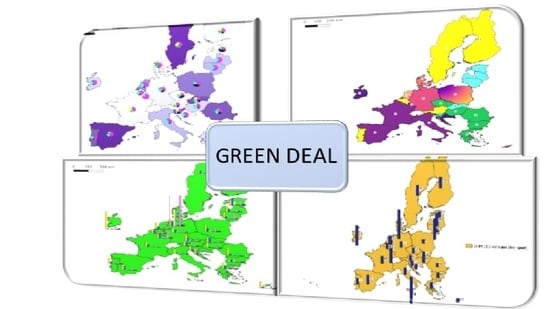Cluster Analysis of the EU-27 Countries in Light of the Guiding Principles of the European Green Deal, with Particular Emphasis on Poland
Abstract
:1. Introduction
- Is there a relationship between the amount of greenhouse gas emissions and the composition of the energy mix of the EU-27 countries?
- Do countries with a coal-based energy mix emit more greenhouse gases per capita?
- What is the largest source of greenhouse gas emissions in countries with the highest CO2 emissions per capita?
- Have the actions taken in individual member states led to the unification of the energy mixes of the EU-27 countries?
2. Literature Review
- The 2030 Climate Target Plan [12], whose implementation is intended to lead to a reduction in greenhouse gas emissions by at least 55% by 2030;
- The European Climate Pact [13], which aims to mobilize and engage citizens of the member states to act for climate protection;
- The European Climate Law [14] for achieving climate neutrality by 2050.
3. Materials and Methods
3.1. Cluster Analysis
- The choice of the number of centroids and their initial arrangement in space;
- The initial random division of the set of objects into k-clusters around centroids: for this purpose, the average distances of individual points are calculated. Then, the objects are assigned to the nearest centroids;
- Updating the position of centroids, e.g., by determining the arithmetic mean of the coordinates of all points;
- Repeat steps 2 and 3 to achieve the convergence criterion. This is the state in which the allocation of points to individual groups has not changed.
3.2. Elbow Method
- k—number of clusters;
- xi—object assigned to a given cluster Sk;
- Ck—cluster centroid.
- A = (,, B = (,—points and their geographic coordinates.
3.3. ARIMA Model
- —the value of the variable in the t period;
- , —model parameters;
- —the quantity of delay;
- —the rest of the model in periods t, …t − q.
- —forecast error;
- —number of observations.
3.4. Trend Surface Analysis
- xi, yi—geographic coordinates;
- zij—dependent variable;
- εij—random component.
4. Results and Discussion
- Productivity (KGOE);
- Import of solid fossil fuels (%);
- Import of oil and petroleum products (excluding biofuel portion) (%);
- Natural gas import (%);
- Solid fossil fuel consumption (TJ);
- Oil and petroleum product consumption (TJ);
- Renewable and biofuel consumption (TJ);
- Natural gas consumption (TJ);
- Nuclear energy consumption (TJ);
- Gross electricity production, solid fossil fuels (1000 toe);
- Gross electricity production, natural gas (1000 toe);
- Gross electricity production, oil and petroleum products (1000 toe);
- Gross electricity production, renewables and biofuels (1000 toe);
- CO2, CH4, N2O, SO2, CO, NOx, PM 2.5, PM10 emission.
5. Discussion
- The diversification of the components of the energy mix so that the share of each of them amounts to about 30%;
- Increasing the share of renewable energy sources while expanding the potential for storing renewable energy;
- Reducing emissions with the simultaneous implementation of technologies for capturing pollutants generated in the combustion process. This would make it possible to maintain coal in the energy mix structure of the EU countries. As a domestic fuel, coal is the basis for energy security, both in terms of the availability of the energy carrier and the maintenance of stable energy system operations;
- The utilization of waste from the coal combustion process, including both gaseous and fly ash, which are valuable sources of rare-earth metals. Such solutions are in line with the assumptions of the circular economy;
- At the same time, more emphasis should be placed on reducing emissions from transport. Currently, the countries of the “new union” and their energy systems may have problems catching up with countries that started implementing a greenhouse gas emissions reduction policy long before them. Therefore, intensive activities in the field of transport should start now, in order to plan activities in this area in advance;
- It is also necessary to pay more attention to other pollutants, not only carbon dioxide. This applies primarily to methane, the negative impact of which on the natural environment is significantly harmful, as well as to pollutants that have a detrimental effect on the life and health of EU citizens. Among the analyzed, these are mainly NOx and dust.
6. Conclusions
- The energy and climate policy of the European Union requires taking very difficult and restrictive steps. Its objectives are correct, but detailed strategies must be developed for groups of countries similar to each other in terms of energy systems;
- It is important to identify the main sources of emissions so that the actions taken are effective;
- The measures taken should not negatively affect the energy security of the European Union and the comfort of citizens’ lives, and this will result from the rapid removal of fossil fuels from the energy mixes of the EU countries;
- The European Union should place emphasis on the transformation of fossil fuel-based energy into an environmentally friendly industry operating in accordance with the guidelines of the circular economy.
Author Contributions
Funding
Institutional Review Board Statement
Informed Consent Statement
Data Availability Statement
Conflicts of Interest
References
- The European Green Deal COM/2019/640. Communication from the Commission to the European Parliament, the European Council, the Council, the European Economic and Social Committee and the Committee of the Regions. Available online: https://eur-lex.europa.eu/legal-content/EN/TXT/uriCOM3A20193A6403AFIN(COM(2019)640 (accessed on 10 November 2021).
- Strategia Ramowa na Rzecz Stabilnej unii Energetycznej Opartej na Przyszłościowej Polityce w Dziedzinie Klimatu. Available online: https://eur-lex.europa.eu/resource.html?uri=cellar:1bd46c90-bdd4-11e4-bbe1-01aa75ed71a1.0007.02/DOC_1&format=PDF (accessed on 12 December 2021).
- Eur-Lex. Available online: https://www.europarl.europa.eu/ReData/etudes/STUD/2018/626092/IPOL_STU(2018)626092_EN.pdf (accessed on 12 December 2021).
- EU Science Hub. Available online: https://ec.europa.eu/jrc/en/news/global-co2-emissions-continue-rise-eu-bucks-global-trend (accessed on 20 December 2021).
- The World Data. Available online: https://data.worldbank.org/indicator/AG.LND.FRST.ZS (accessed on 20 December 2021).
- Eurostat. 2020. Available online: https://ec.europa.eu/eurostat/data/database (accessed on 7 October 2021).
- Mac Kinnon, M.A.; Brouwer, J.; Samuelsen, S. The Role of Natural Gas and its Infrastructure in Mitigating Greenhouse Gas Emissions, Improving Regional Air Quality, and Renewable Resource Integration. Prog. Energy Combust. Sci. 2018, 64, 62–92. [Google Scholar] [CrossRef]
- Kittner, N.; Fadadu, R.P.; Buckley, H.L.; Schwarzman, M.R.; Kammen, D.M. Trace Metal Content of Coal Exacerbates Air-Pollution-Related Health Risks: The Case of Lignite Coal in Kosovo. Environ. Sci. Technol. 2018, 52, 2359–2367. [Google Scholar] [CrossRef] [Green Version]
- IPCC. Climate Change-Response Strategies. IPCC, 1990. Available online: https://www.ipcc.ch/sie/assets/uploads/2018/03/ipcc_far_wg_III_full_report.pdf (accessed on 30 July 2019).
- European Commission. European Community Gas Supply And Prospects-COM(95) 478 Final. 1995. Available online: http://aei.pitt.edu/4999/1/4999.pdf (accessed on 1 August 2019).
- Flavin, C.; Lenssen, N. Power Surge: Guide to the Coming Energy Revolution; No. 333.79 F589; W. W. Norton & Company: New York, NY, USA, 1994. [Google Scholar]
- 2030 Climate Target Plan. Available online: https://ec.europa.eu/clima/eu-action/european-green-deal/2030-climate-target-plan_en (accessed on 1 June 2022).
- European Climate Pact. Available online: https://europa.eu/climate-pact/index_en (accessed on 1 June 2022).
- European Climate Law. Available online: https://ec.europa.eu/clima/eu-action/european-green-deal/european-climate-law_en (accessed on 4 June 2022).
- Rogelj, J.; Popp, A.; Calvin, K.V.; Luderer, G.; Emmerling, J.; Gernaat, D.; Fujimori, S.; Strefler, J.; Hasegawa, T.; Marangoni, G.; et al. Scenarios towards limiting global mean temperature increase below 1.5 °C. Nat. Clim. Chang. 2018, 8, 325–332. [Google Scholar] [CrossRef]
- Adoption of the Paris AgreementFCCC/CP/2015/L.9/Rev.1 (UNFCCC, 2015). Available online: https://unfccc.int/resource/docs/2015/cop21/eng/l09r01.pdf (accessed on 4 June 2022).
- Cao, L.; Caldeira, K. Atmospheric carbon dioxide removal: Long-term consequences and commitment. Environ. Res. Lett. 2010, 5, 24011. [Google Scholar] [CrossRef]
- Tokarska, K.; Zickfeld, K. The effectiveness of net negative carbon dioxide emissions in reversing anthropogenic climate change. Environ. Res. Lett. 2015, 10, 94013. [Google Scholar] [CrossRef] [Green Version]
- Zickfeld, K.; Azevedo, D.; Mathesius, S.; Matthews, H.D. Asymmetry in the climate–carbon cycle response to positive and negative CO2 emissions. Nat. Clim. Chang. 2021, 11, 613–617. [Google Scholar] [CrossRef]
- Roddy, D.J.; Younger, P.L. Underground coal gasification with CCS: A pathway to decarbonising industry. Energy Environ. Sci. 2010, 3, 400–407. [Google Scholar] [CrossRef]
- Sarfraz, M.; Ba-Shammakh, M. Water-stable ZIF-300/Ultrason® mixed-matrix membranes for selective CO2 capture from humid postcombustion flue gas. Chin. J. Chem. Eng. 2018, 26, 1012. [Google Scholar] [CrossRef]
- Rybak, A.; Rybak, A. Methods of Ensuring Energy Security with the Use of Hard Coal—The Case of Poland. Energies 2021, 14, 5609. [Google Scholar] [CrossRef]
- Burke, A.; Fishel, S. A coal elimination treaty 2030: Fast tracking climate change mitigation, global health and security. Earth Syst. Gov. 2020, 3, 1–9. [Google Scholar] [CrossRef]
- Twitter. Available online: https://twitter.com/RCB_RP/status/1466355518033780738 (accessed on 11 December 2021).
- Rybak, A. Rola I PrzyszłOść Węgla W Zapewnieniu Bezpieczeństwa Energetycznego Polski; Monografia 865, Wydawnictwo Politechniki Śląskiej: Gliwice, Poland, 2020. [Google Scholar]
- McQueen, J. Some Methods for Classification and Analysis of Multivariate Observations. In Proceedings of the Fifth Berkeley Symposium on Mathematical Statistics and Probability; U of California Press: Berkeley, CA, USA, 1967; Volume 1, pp. 281–297. [Google Scholar]
- Syakur, M.A.; Khotimah, B.K.; Rochman, E.M.S.; Satoto, B.D. Integration K-means clustering method and Elbow method for identification of the best customer profile cluster. IOP Conf. Ser. Mater. Sci. Eng. 2018, 335, 012017. [Google Scholar] [CrossRef] [Green Version]
- Thorndike, R.L. Who belongs in the family? Psychometrika 1953, 18, 267–276. [Google Scholar] [CrossRef]
- Nainggolan, R.; Perangin-angin, R.; Simarmata, E.; Tarigan, A. Improved the performance of the K-means cluster using the sum of squared error (SSE) optimized by using the Elbow method. J. Phys. Conf. Ser. 2019, 1361, 012015. [Google Scholar] [CrossRef]
- Yun, H.J.; Kang, D.J.; Kim, D.-K.; Kang, Y. A GIS-Assisted Assessment and Attribute-Based Clustering of Forest Wetland Utility in South Korea. Sustainability 2019, 11, 4632. [Google Scholar] [CrossRef] [Green Version]
- Bluszcz, A. European economies in terms of energy dependence. Qual Quant. 2017, 51, 1531–1548. [Google Scholar] [CrossRef] [PubMed] [Green Version]
- Le Roux, B.; Rouanet, H. Geometric Data Analysis: From Correspondence Analysis to Structured Data Analysis; Kluwer: Dordrecht, The Netherlands, 2004; p. xi + 475. [Google Scholar]
- Kufel, T. Ekonometria. Rozwiązywanie Problemów Z Wykorzystaniem Programu Gretl; PWN Warszawa: Warsaw, Poland, 2004. [Google Scholar]
- Kot, S.; Jakubowski, J.; Sokołowski, A. Statystyka; Difin: Warsaw, Poland, 2007. [Google Scholar]
- Piłatowska, M. Kryteria informacyjne w wyborze modelu ekonometrycznego. Studia I Pr. Uniw. Ekon. W Krakowie 2010, 140, 25–37. [Google Scholar]
- Almorox, J.; Benito, M.; Hontoria, C. Estimation of monthly Angström–Prescott equation coefficients from measured daily data in Toledo, Spain. Renew. Energy 2005, 30, 931–936. [Google Scholar] [CrossRef]
- Said, S.; Zeroual, A. Prediction of global daily solar radiation using higher order statistics. Renew. Energy 2002, 27, 647–666. [Google Scholar] [CrossRef]
- Bliemel, F. Theil’s Forecast Accuracy Coefficient: A Clarification. J. Mark. Res. 1973, 10, 444–446. [Google Scholar] [CrossRef]
- Farnum, N.R.; Stanton, W. Quantitative Forecasting Methods; PWS-Kent Publishing Company: Boston, MA, USA, 1989. [Google Scholar]
- Watson, G.S. Trend-surface analysis. Math. Geol. 1971, 3, 215–226. [Google Scholar] [CrossRef]
- Li, J.; Heap, A.D. Spatial interpolation methods applied in the environmental sciences: A review. Environ. Model. Softw. 2014, 53, 173–189. [Google Scholar] [CrossRef]
- Sen, Z. Spatial Modeling Principles in Eearth Sciences; Springer: New York, NY, USA, 2009. [Google Scholar]
- Instytut Badań Rynku Motoryzacyjnego. Available online: https://www.samar.pl/ (accessed on 7 December 2021).
- Xu, B.; Lin, B. Reducing carbon dioxide emissions in China’s manufacturing industry: A dynamic vector autoregression approach. J. Clean. Prod. 2016, 131, 594–606. [Google Scholar] [CrossRef]
- Bebkiewicz, K.; Chłopek, Z.; Lasocki, J.; Szczepański, K.; Zimakowska-Laskowska, M. Analysis of Emission of Greenhouse Gases from Road Transport in Poland between 1990 and 2017. Atmosphere 2020, 11, 387. [Google Scholar] [CrossRef] [Green Version]
- Claeys, G.; Tagliapietra, S.; Zachmann, G. How to Make the European Green Deal Work; Bruegel: Brussels, Belgium, 2019. [Google Scholar]
- European Commission—Press Release: No region Left Behind: Launch of the Platform for Coal Regions in Transition. Strasbourg. 11 December 2017. Available online: https://ec.europa.eu/commission/presscorner/detail/en/IP_17_5165 (accessed on 2 July 2021).
- Tomaszewski, K. The Polish road to the new European Green Deal—Challenges and threats to the national energy policy. Polityka Energetyczna Energy Policy J. 2020, 23, 5–18. [Google Scholar] [CrossRef]
- Frejowski, A.; Bondaruk, J.; Duda, A. Challenges and Opportunities for End-of-Life Coal Mine Sites: Black-to-Green Energy Approach. Energies 2021, 14, 1385. [Google Scholar] [CrossRef]
- Apostu, I.M.; Lazar, M.; Faur, F. Implications of coal disappearance from the energy mix in Romania. In Proceedings of the MATEC Web of Conferences 2022, Sesam 2021, Petrosani, Romania, 18 October 2021; p. 354. [Google Scholar]
- Safari, A.; Das, N.; Langhelle, O.; Roy, J.; Assadi, M. Natural gas: A transition fuel for sustainable energy system transformation? Energy Sci. Eng. 2019, 7, 1075–1094. [Google Scholar] [CrossRef]
- Kavouridis, K.; Koukouzas, N. Coal and sustainable energy supply challenges and barriers. Energy Policy 2008, 36, 693–703. [Google Scholar] [CrossRef]
- Bugge, J.; Kjær, S.; Blum, R. High-efficiency coal-fired power plants development and perspectives. Energy 2006, 31, 1437–1445. [Google Scholar] [CrossRef]
- Rybak, A.; Manowska, A. The future of crude oil and hard coal in the aspect of Poland’s energy security. Energy Policy J. 2018, 21, 141–154. [Google Scholar] [CrossRef]
- Bryan, N.; Lasseuguette, E.; van Dalen, M.; Permogorov, N.; Amieiro, A.; Brandani, S.; Ferrari, M.C. Development of mixed matrix membranes containing zeolites for post-combustion carbon capture. Energy Procedia 2014, 63, 160–166. [Google Scholar] [CrossRef] [Green Version]
- Sridhar, S.; Smith, B.; Ramakrishna, M.; Aminabhavi, T.M. Modified poly(phenylene oxide) membranes for the separation of carbon dioxide from methane. J. Membrane Sci. 2006, 280, 202–209. [Google Scholar] [CrossRef]
- Kokkoli, A.; Zhan, Y.; Angelidaki, I. Microbial electrochemical separation of CO2 for biogas upgrading. Bioresour. Technol. 2018, 247, 380–386. [Google Scholar] [CrossRef] [Green Version]
- Xiang, L.; Pan, Y.; Jiang, J.; Chen, Y.; Chen, J.; Zhang, L.; Wang, C. Thin poly(ether-block-amide)/attapulgite composite membranes with improved CO2 permeance and selectivity for CO2/N2 and CO2/CH4. Chem. Eng. Sci. 2017, 160, 236–244. [Google Scholar] [CrossRef]
- Rybak, A.; Joostberens, J.; Manowska, A.; Pielot, J. The Impact of Environmental Taxes on the Level of Greenhouse Gas Emissions in Poland and Sweden. Energies 2022, 15, 4465. [Google Scholar] [CrossRef]
- Kolker, A.; Scott, C.; Hower, J.C.; Vazquez, J.A.; Lopano, C.L.; Dai, S. Distribution of rare earth elements in coal combustion fly ash, determined by SHRIMP-RG ion microprobe. Int. J. Coal Geol. 2017, 184, 1–10. [Google Scholar] [CrossRef]
- Lin, R.; Howard, B.H.; Roth, E.A.; Bank, T.L.; Granite, E.J.; Soong, Y. Enrichment of rare earth elements from coal and coal by-products by physical separations. Fuel 2017, 200, 506–520. [Google Scholar] [CrossRef] [Green Version]
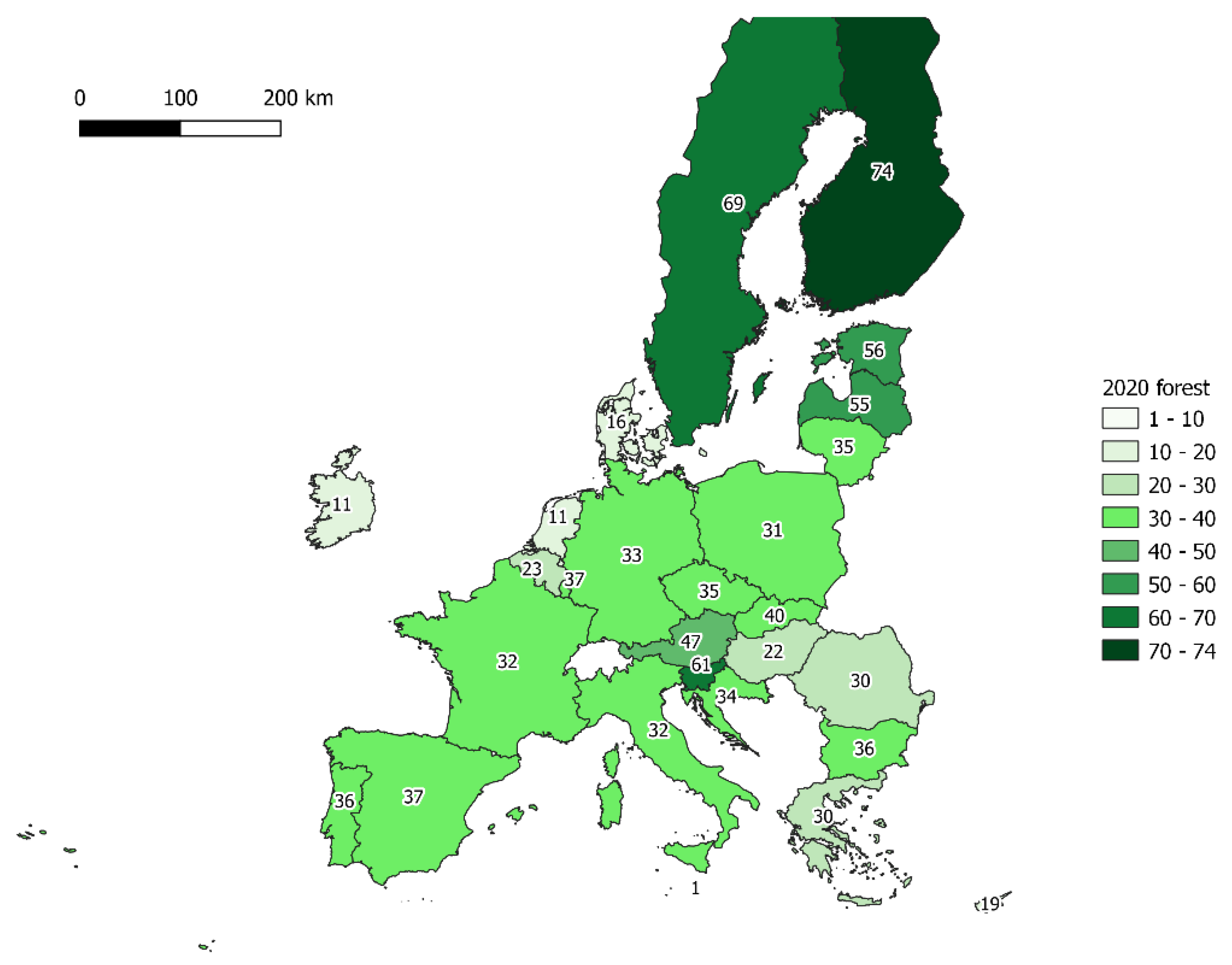
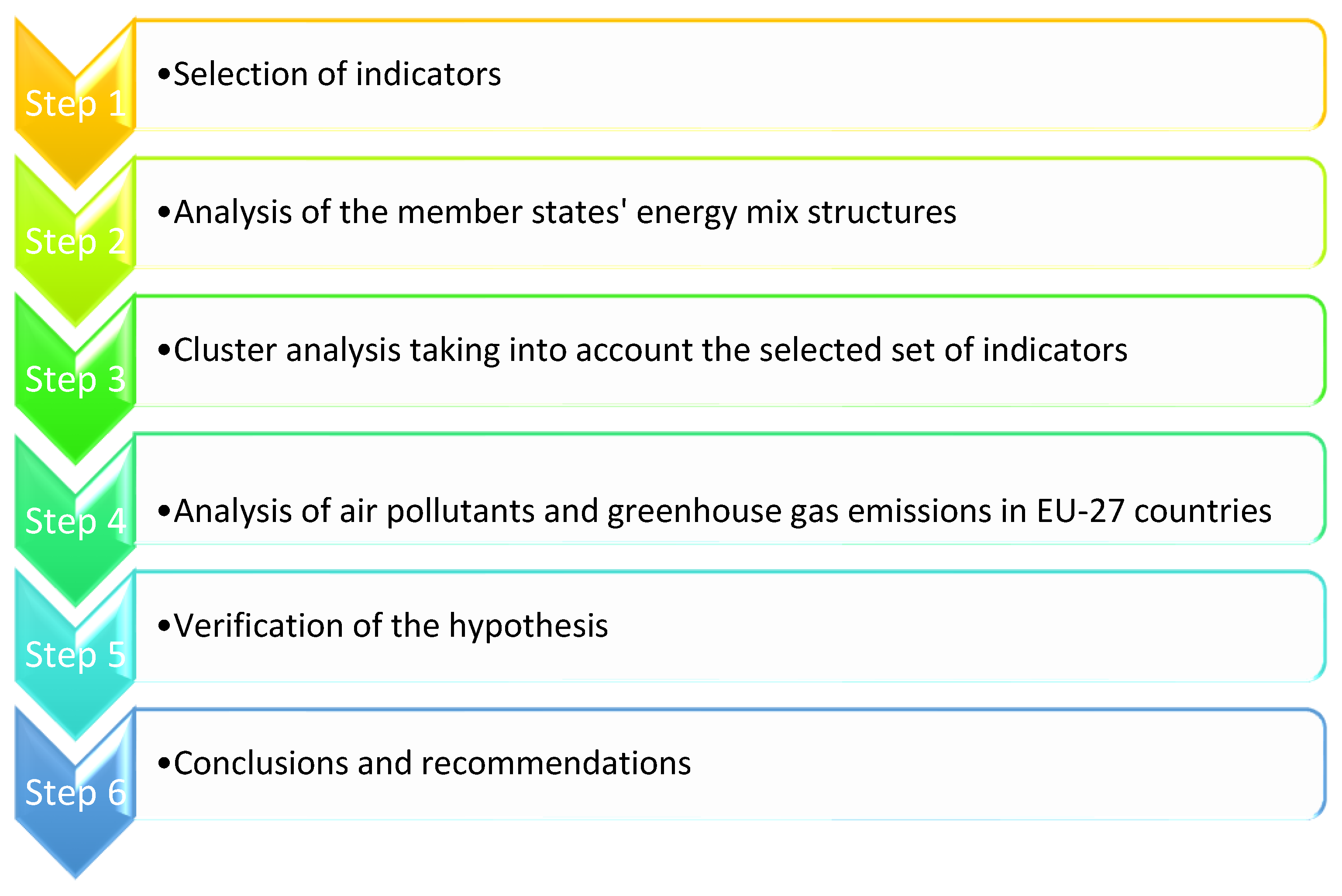


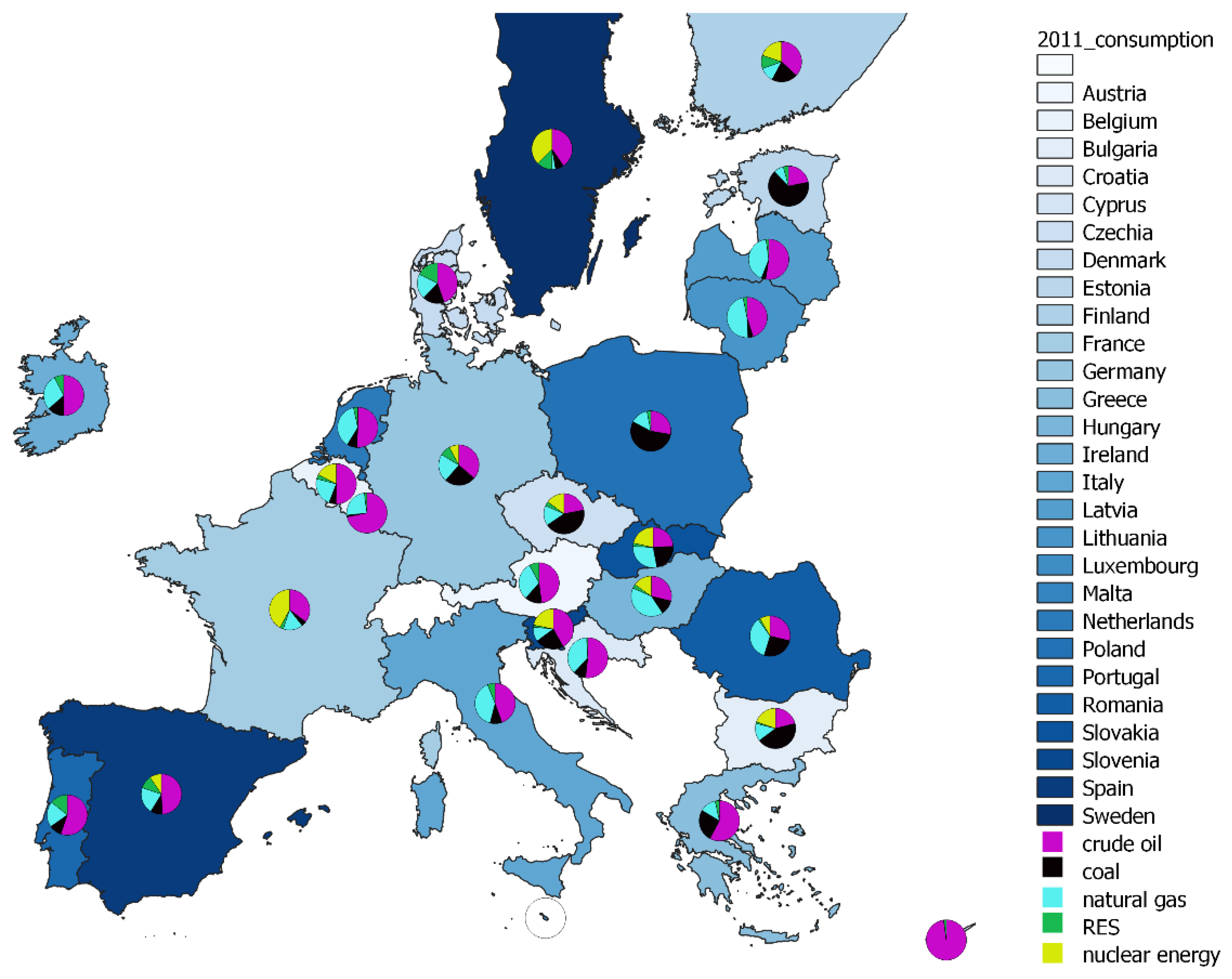
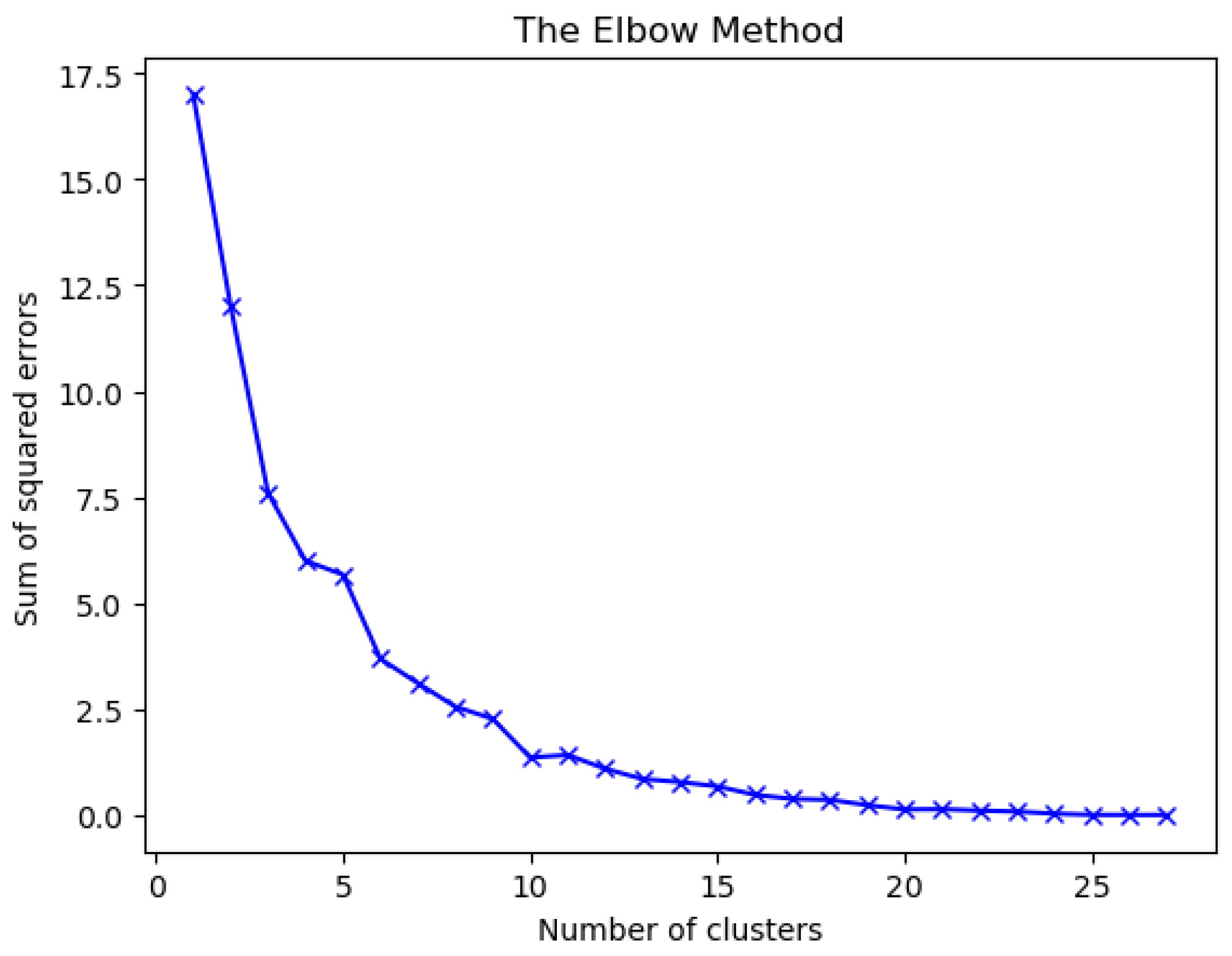

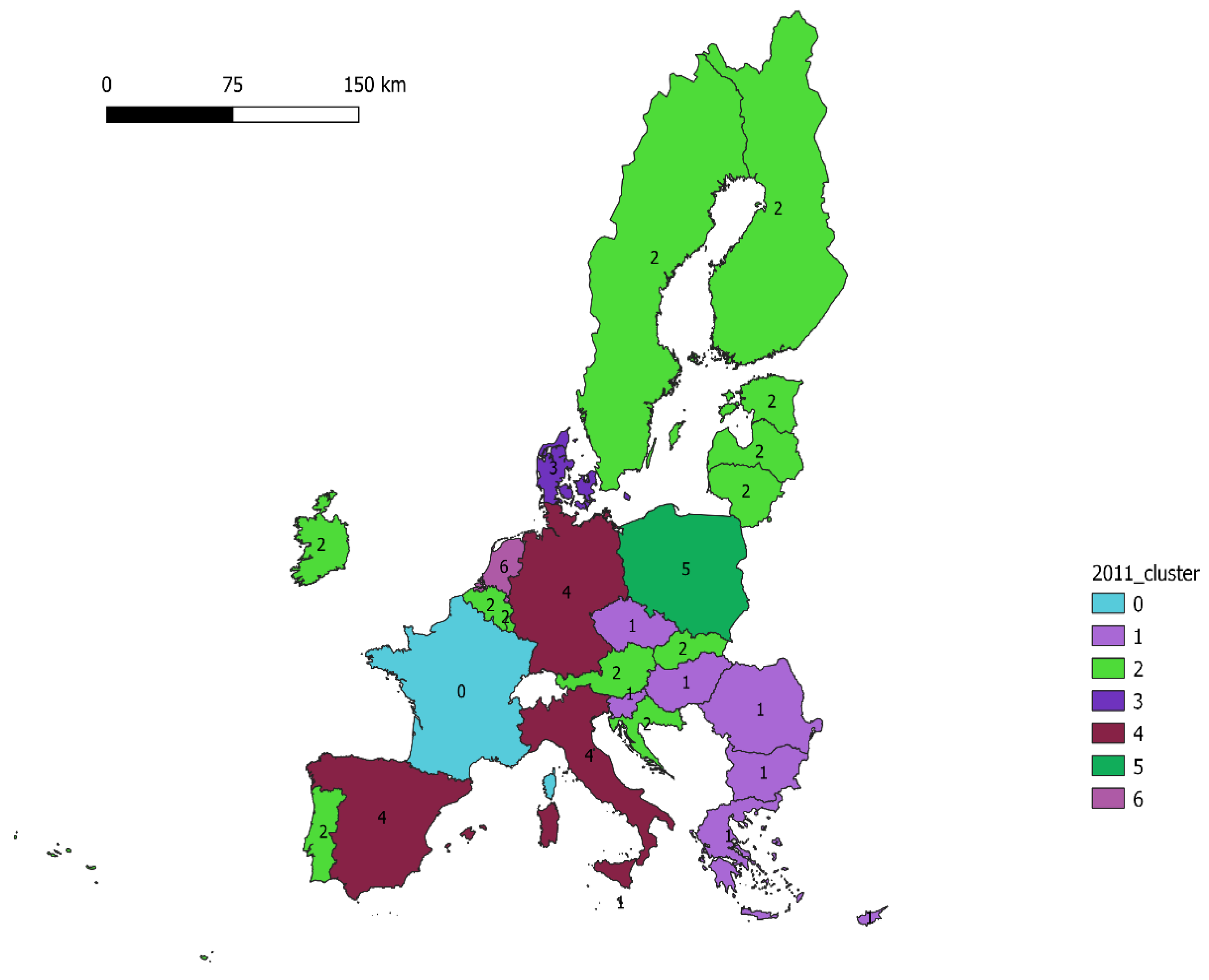
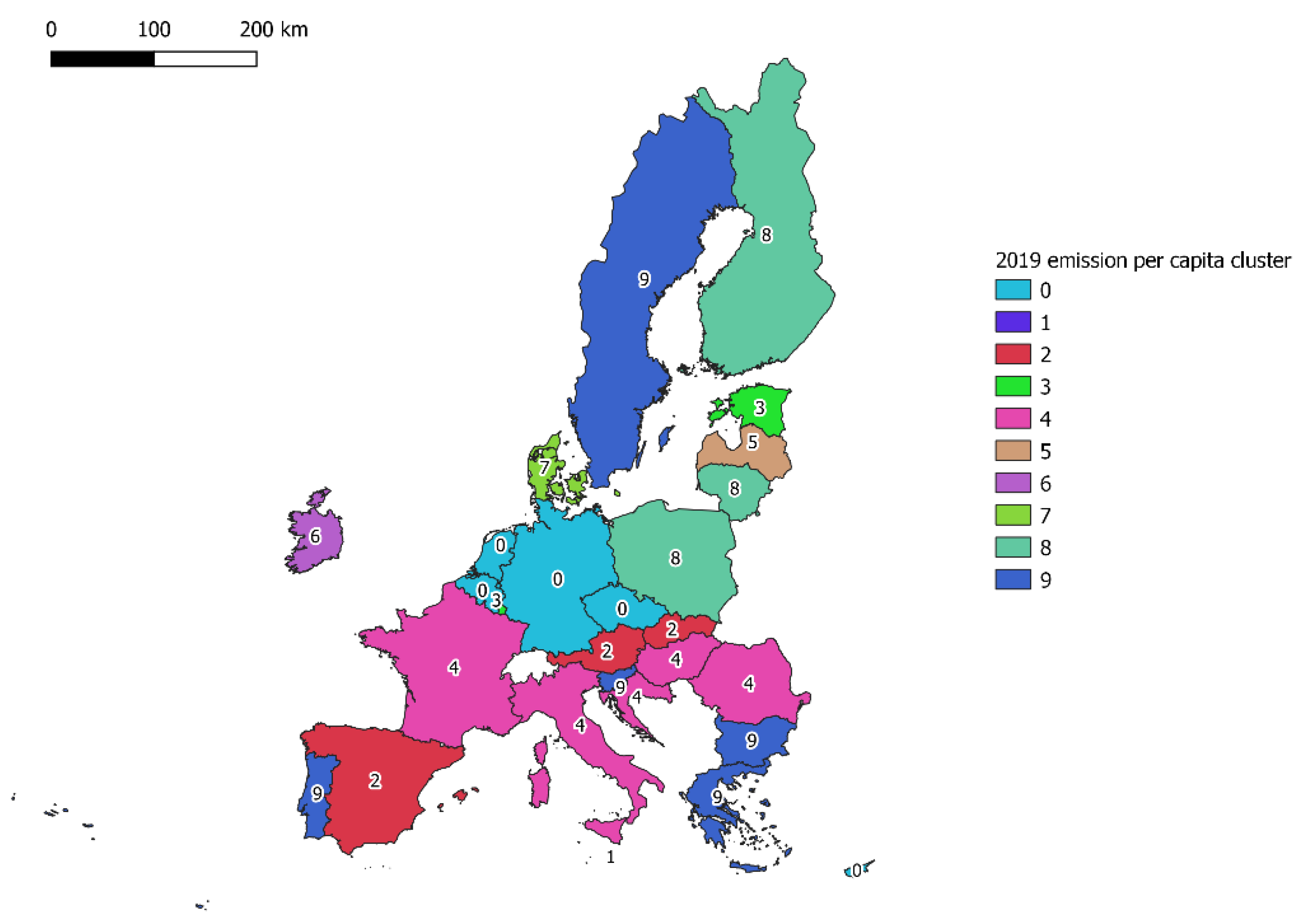



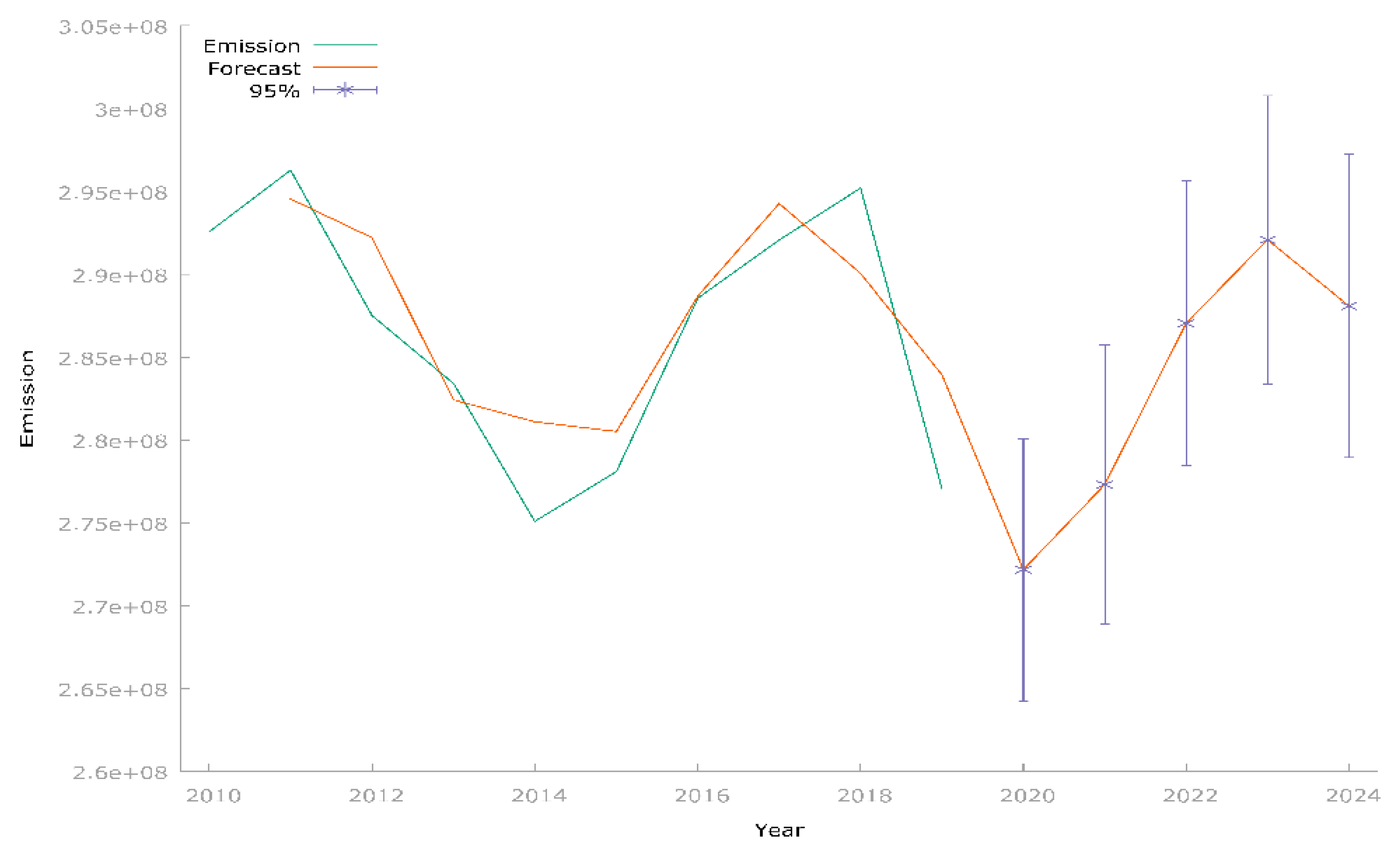


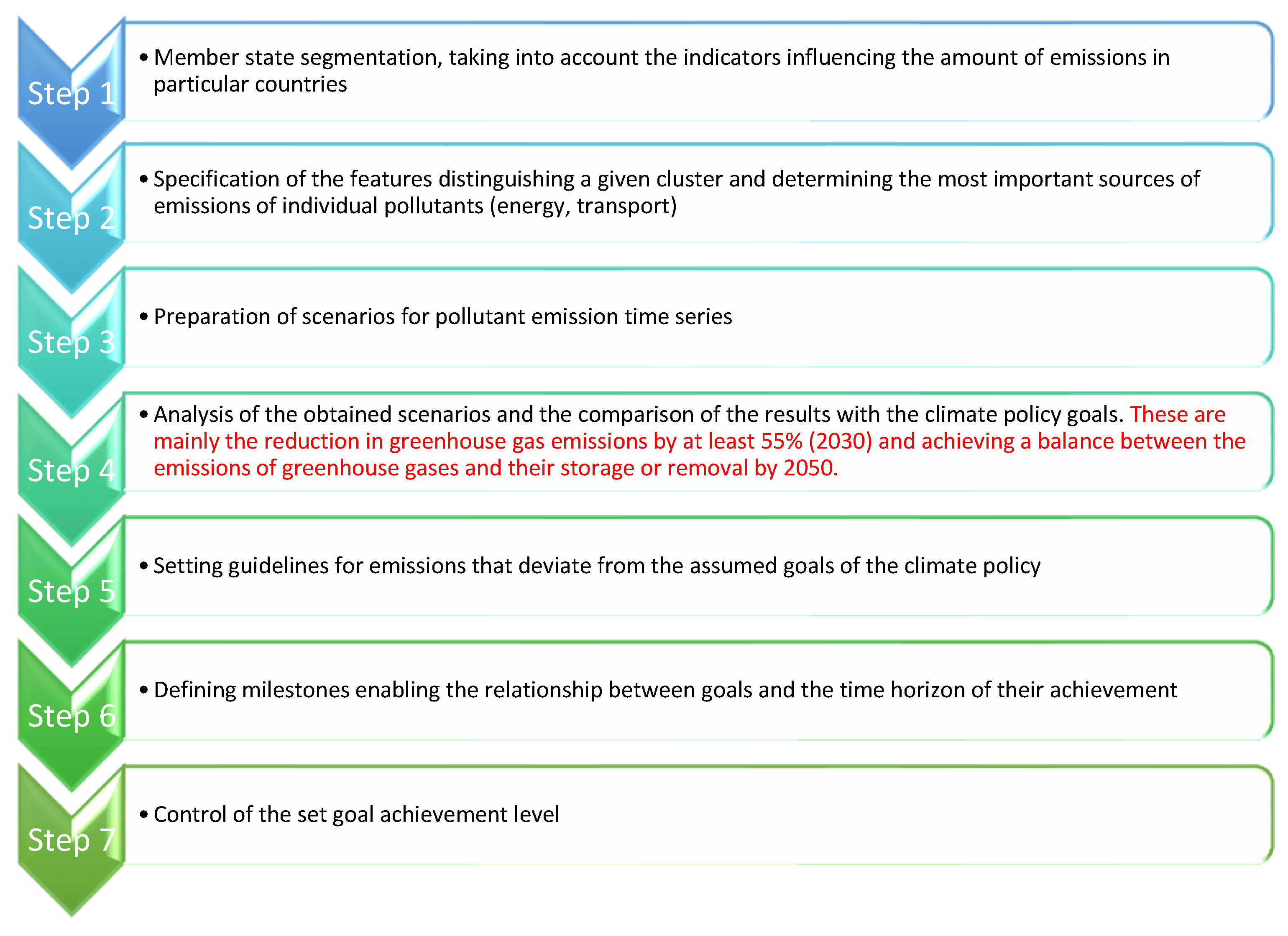
| Index | Index Value |
|---|---|
| Akaike information criterion (AIC) | 316 |
| Bayesian information criterion (BIC)–Hannan | 317 |
| Quinn information criterion (HQ) | 316 |
| RMSE | 4.03 × 106 |
| MAPE, % | 1.2 |
Publisher’s Note: MDPI stays neutral with regard to jurisdictional claims in published maps and institutional affiliations. |
© 2022 by the authors. Licensee MDPI, Basel, Switzerland. This article is an open access article distributed under the terms and conditions of the Creative Commons Attribution (CC BY) license (https://creativecommons.org/licenses/by/4.0/).
Share and Cite
Rybak, A.; Rybak, A.; Joostberens, J.; Kolev, S.D. Cluster Analysis of the EU-27 Countries in Light of the Guiding Principles of the European Green Deal, with Particular Emphasis on Poland. Energies 2022, 15, 5082. https://doi.org/10.3390/en15145082
Rybak A, Rybak A, Joostberens J, Kolev SD. Cluster Analysis of the EU-27 Countries in Light of the Guiding Principles of the European Green Deal, with Particular Emphasis on Poland. Energies. 2022; 15(14):5082. https://doi.org/10.3390/en15145082
Chicago/Turabian StyleRybak, Aurelia, Aleksandra Rybak, Jarosław Joostberens, and Spas D. Kolev. 2022. "Cluster Analysis of the EU-27 Countries in Light of the Guiding Principles of the European Green Deal, with Particular Emphasis on Poland" Energies 15, no. 14: 5082. https://doi.org/10.3390/en15145082
APA StyleRybak, A., Rybak, A., Joostberens, J., & Kolev, S. D. (2022). Cluster Analysis of the EU-27 Countries in Light of the Guiding Principles of the European Green Deal, with Particular Emphasis on Poland. Energies, 15(14), 5082. https://doi.org/10.3390/en15145082








